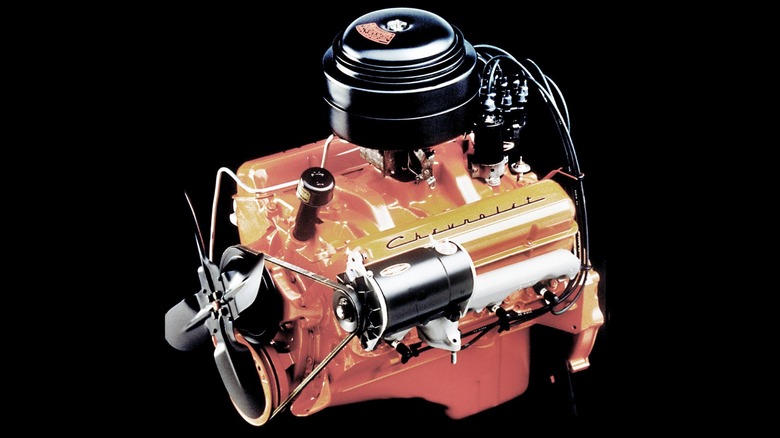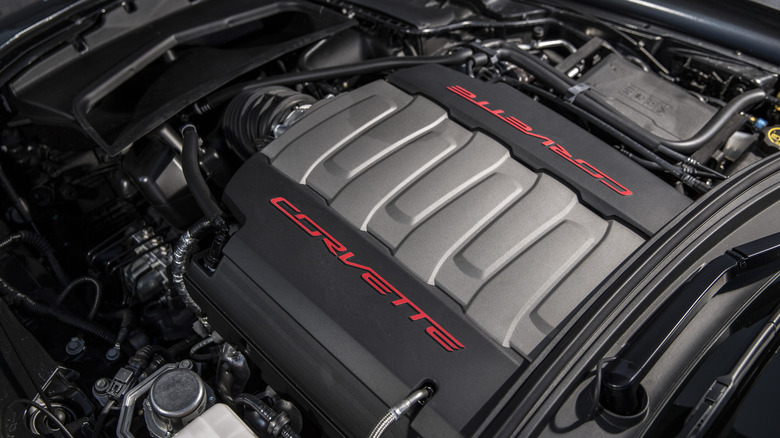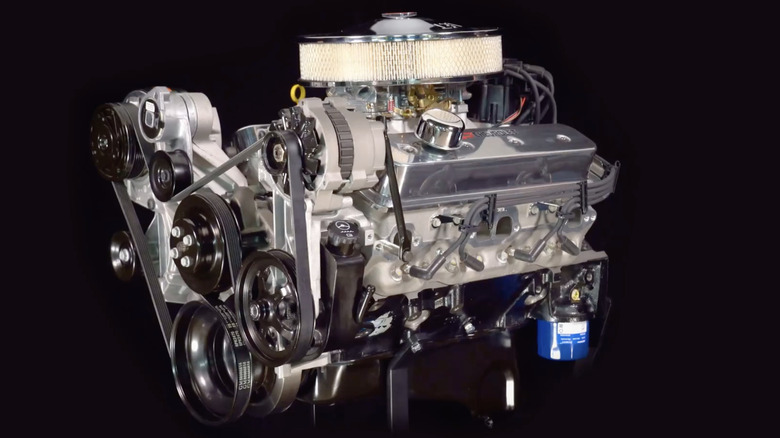This Engine Has Powered More Cars Than Any Other In History
The small-block Chevrolet V8 has powered over 100 million vehicles throughout the years, providing power for everything from high-horsepower muscle cars to workhorse pickup trucks. It's also one of the most commonly used engines for classic-car engine swaps. To put the high-selling numbers of the V8 into perspective, one of the most popular cars of all time — the Toyota Corolla — has sold over 50 million units. It took nearly 60 years for Toyota to reach that milestone back in 2021, and it continues to do well today, but even that impressive number doesn't come close to the numbers posted by the small-block V8. The V8 does have the distinct advantage of being under the hood of all sorts of cars, trucks, and SUVs.
The Chevrolet small-block V8 was introduced in 1955 with 265 cubic inches of displacement. At the time, it was used in the Corvette and in Chevy's pickup trucks. In the Corvette, the small-block grew in size and later expanded in scope, powering the Camaro and Bel Air.
Cars like the Chevy Nova, Chevelle, Caprice, and even the Chevrolet Van were all powered by the small-block. Cadillacs, Buicks, Pontiacs, Oldsmobiles, and even the Hummer H1 all had beating small-block-V8 hearts. Depending on what you classify as a "small-block" Chevy V8, there are still several products from Chevrolet, GMC, and Cadillac using a variant from the same engine family today.
Progress of the small-block V8 over time
One of Chevrolet's most popular vehicles for decades, as well as one of the most popular vehicles in America, is the Silverado pickup truck. With towing and hauling as its main tasks, it's a natural home for a robust V8 — and a good way to track the progress of the small-block V8 is follow its history in the Silverado.
The first-generation small-block fitted to Chevy pickup trucks put out 180 horsepower and 260 lb-ft of torque. By 1960, the engine in those trucks grew to 283 cubic inches, and by 1972, it was a full 350 cubic inches. Various generations of the small-block were released in the subsequent decades, including the infamous 5.3-liter EcoTec3 V8. These days, a 5.3-liter version and a 6.2-liter version of the small-block V8 power various Silverado models.
Not everyone considers the current LS engines part of the Chevy small-block family, since they were technically redesigned in 1997. There are some differences between the engines, such as the firing order. However, Chevy says that the current engines are part of the same family, so we'll go with that designation. The LS 5.3-liter V8 currently powering the Silverado 1500 makes 355 hp and 383 lb-ft of torque, while the 6.2-liter engine makes 420 hp and 460 lb-ft, which is much more than the early 265 cubic-inch engines. Then, of course, there are forced-induction versions of the small-block V8, like the Gen-V LT5 that powered the C7 Corvette, putting out 755 hp.
It's all about the swaps
On top of being available under the hood of many modern Chevrolet products, the latest iterations of its small-block V8s are available as crate engines, too. They can be purchased directly from Chevrolet, so you can upgrade your hot rod, restomod, or full-fledged race car build without digging through your local salvage yard.
Chevrolet small-block crate engines that offer 5.7 liters of displacement currently range in power output from 333 hp and 381 lb-ft with the 350 HO engine, all the way up to 420 hp and 408 lb-ft of torque with the ZZ6 EFI engine. The larger 383 stroker models increase overall displacement to 6.3 liters and produce up to 450 hp and 436 lb-ft.
The LS engine is also a very popular swap, valued for its versatility and broad parts availability. Finding replacement and upgrade parts is easy, the engines themselves are durable, and they can be found in many cars produced over the years.


